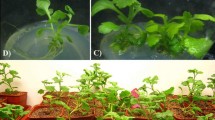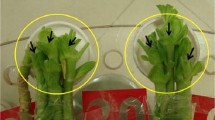Abstract
We investigated the structural genes and their transcripts for anthocyanin synthesis inDendranthema grandiflorum ‘Argus’. Color variations in chrysanthemum mutants were obtained through gamm ray irradiation to regenerated plants from anin vitro. Normal florets were pinkish, but the mutants had white or purple ray florets and white, purple, or yellow-green disc florets. Irradiation modified both flower size and the number of ray florets. Compared with the control, levels of total anthocyanins in the mutants ranged from 4 times lower to 6 times higher for the disc florets. This disparity was even more evident, up to 14-fold greater, in the ray florets. Expression of the CHI, F3′H, F3′5′H, DFR, and LDOX genes varied among the mutants, but no dramatic changes were detected in CHS and F3H transcripts in either leaf or floret tissues. Sequence homology to known anthocyanin genes from other plant species was 61 to 84%, 62 to 74%, and 71 to 76% for CHI, F3′H, and LDOX, respectively. Our results support the proposal that such radiation-induced mutations in genes within the anthocyanin pathway are associated with variations in chrysanthemum flower color.
Similar content being viewed by others
Literature Cited
Ahloowalia BS, Maluszynski M (2001) Induced mutations — A new paradigm in plant breeding. Euphytica 118:167–173
Broertjes C, Roest S, Bokelmann GS (1976) Mutation breeding ofChrysanthemum morifolium Ram. usingin vivo andin vitro adventitious bud techniques. Euphytica 25: 11–19
Christie PJ, Alfenito MR, Walbot V (1994). Impact of low-temperature stress on general phenylpropanoid and anthocyanin pathways: Enhancement of transcript abundance and anthocyanin pigmentation in maize seedlings. Planta 194: 541 -549
Emmanuel E, Levy AA (2002) Tomato mutants as tools for functional genomics. Curr Opin Plant Biol 5: 112–117
Grotewold E (2006) The genetics and biochemistry of floral pigments. Annu Rev Plant Biol 57: 761–780
Holton TA, Cornish EC (1995) Genetics and biochemistry of anthocyanin biosynthesis. Plant Cell 7: 1071–1083
Hoshino A, Johzuka-Hisatomi Y, Iida S (2001) Gene duplication and mobile genetic elements in the morning glories. Gene 265: 1–10
Jaakola L, Maatta K, Pirttila AM, Torronen R, Karenlampi S, Hohtola A (2002) Expression of genes involved in anthocyanin biosynthesis in relation to anthocyanin, proanthocyanidin, and flavonol levels during bilberry fruit development. Plant Physiol 130: 729–739
Jain SM (2005) Major mutation-assisted plant breeding programs supported by FAO/IAEA. Plant Cell Tiss Org Cult 82: 113–123
Jeong ST, Goto-Yamamoto N, Hashizume K, Esaka M (2006) Expression of the flavonoid 3′-hydroxylase and flavonoid 3′5′-hydroxylase genes and flavonoid composition in grape(Vitis vinifera). Plant Sci 170: 61–69
Kim BG, Kim JH, Min SY, Shin K-H, Kim JH, Kim HY, Ryu SN, Ahn J-H (2007) Anthocyanin content in rice is related to expression levels of anthocyanin biosynthetic genes. J Plant Biol 50: 156–160
Kimler L, Mears J, Mabry TJ, Roesler H (1970) On the question of the mutual exclusiveness of betalains and anthocyanins. Taxon 19:875–878
Levin I, Lalazar A, Bar M, Schaffer AA (2004) Non GMO fruit factories: Strategies for modulating metabolic pathways in the tomato fruit. Ind Crop Prod 20: 29–36
Maluszynski M, Ahloowalia BS, Sigurbjornsson B (1995) Application ofin vivo andin vitro mutation techniques for crop improvement. Euphytica 85: 303–315
Mandal AKA, Chakrabarty D, Datta SK (2000).In vitro isolation of solid novel flower color mutants from induced chimeric ray florets of chrysanthemum. Euphytica 114: 9–12
Marles MAS, Ray H, Gruber MY (2003) New perspectives on proanthocyanidin biochemistry and molecular regulation. Phytochemistry 64: 367–383
Martin T, Oswald O, Graham IA (2002) Arabidopsis seedling growth, storage lipid mobilization, and photosynthetic gene expression are regulated by carbon: Nitrogen availability. Plant Physiol 128: 472–481
Mato M, Onozaki T, Ozeki Y, Higeta D, Itoh Y, Yoshimoto Y, Ikeda H, Yoshida H, Shibata M (2000) Flavonoid biosynthesis in white-flowered Sim carnations (Dianthus caryophyllus). Sci Hort 84: 333–347
Miyazaki K, Suzuki K, Iwaki K, Kusumi T, Abe T, Yoshida S, Fukui H (2006) Flower pigment mutations induced by heavy ion beam irradiation in an interspecific hybrid ofTorenia. Plant Biotech 23: 163–167
Nakatsuka T, Nishihara M, Mishiba K, Yamamura S (2005) Two different mutations are involved in the formation of white-flowered gentian plants. Plant Sci 169: 949–958
Nissim-Levi A, Ovadiar R, Forer I, Oren-Shamir M (2007) Increased anthocyanin accumulation in ornamental plants due to magnesium treatment. J Hortic Sci Biotech 82: 481–487
Okamura M, Yasuno N, Ohtsuka M, Tanaka A, Shikazono N, Hase Y (2003) Wide variety of flower-color and shape mutants regenerated from leaf cultures irradiated with ion beams. Nucl Instrum Methods Phys Res Sect B 206: 574–578
Ohmiya A, Kishimoto S, Aida R, Yoshioka S, Sumitomo K (2006) Carotenoid cleavage dioxygenase (CmCCD4a) contributes to white color formation in chrysanthemum petals. Plant Physiol 142: 1193–1201
Park IS, Lee GJ, Kim DS, Chung SJ, Kim JB, Song HS, Goo DH, Kang SY (2007) Mutation breeding of a spray chrysanthemum ‘Argus’ by gamma-ray irradiation and tissue culture. Flower Res J 15: 52–57
Predieri S (2001) Mutation induction and tissue culture in improving fruits. Plant Cell Tiss Org Cult 64: 185–210
Sanjay J (2007). Mutagenesis: Generation and evaluation of induced mutations. Adv Bot Res 45: 417–434
Schum A (2003) Mutation breeding in ornamentals: An efficient breeding method? Acta Hort 612: 47–58
Seitz C, Vitten M, Steinbach R Hartl S, Hirsche J, Rathje W, Treutter D, Forkmann G (2007) Redirection of anthocyanin synthesis inOsteospermum hybrida by a two-enzyme manipulation strategy. Phytochemistry 68: 824–833
Seo J, Kim SW, Kim J, Cha HW, Liu JR (2007) Co-expression of flavonoid 3′, 5′-hydroxylase and flavonoid 3′-hydroxylase accelerates decolorization in transgenic chrysanthemum petals. J Plant Biol 50: 626–631
Shikazono N, Yokota Y, Kitamura S, Suzuki C, Watanabe H, Tano S, Tanaka A (2003) Mutation rate and noveltt mutants ofArabidopsis thaliana induced by carbon ions. Genetics 163: 1449–1455
Shimada Y, Ohbayashi M, Nakano-Shimada R, Okinaka Y, Kiyokawa S, Kikuchi Y (2001) Genetic engineering of the anthocyanin biosynthetic pathway with flavonoid-3′,5′-hydroxylase: Specific switching of the pathway in petunia. Plant Cell Rep 20: 456–462
Sun M, Li R Zhang Q-X (2007) Flower color and florescence mutants obtained using electron beam irradiation of chrysanthemum buds. Acta Hort 760: 667–672
Turnbull JJ, Nakajima J-I, Welford RWD, Yamazaki M, Saito K, Schofield CJ (2004) Mechanistic studies on three 2-oxoglut-arate-dependent oxygenases of flavonoid biosynthesis. J Biol Chem 279: 1206–1216
Zalewska M, Jerzy M (1997) Mutation spectrum inDendranthema grandiflora Tzvelev afterin vivo andin vitro regeneration of plants from irradiated leaves. Acta Hort 447: 615–618
Author information
Authors and Affiliations
Corresponding author
Rights and permissions
About this article
Cite this article
Lee, GJ., Chung, S.J., Park, I.S. et al. Variation in the phenotypic features and transcripts of color mutants of chrysanthemum (Dendranthema grandiflorum) derived from gamma ray mutagenesis. J. Plant Biol. 51, 418–423 (2008). https://doi.org/10.1007/BF03036063
Received:
Accepted:
Issue Date:
DOI: https://doi.org/10.1007/BF03036063




